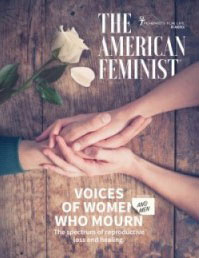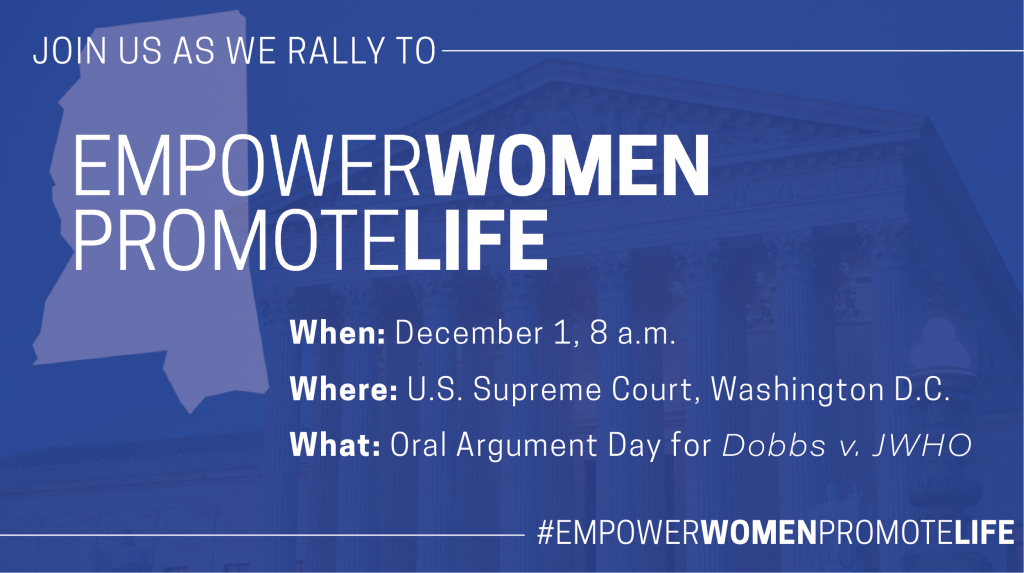The unwelcome presence of blood awakened me on a dark day in December. I was 12 weeks pregnant with my first baby. I went to work that day in an office where hardly anyone knew of my pregnancy, evening found me in a hospital emergency room, lying on an exam table with my husband by my side. While an unshaven, bleary-eyed young man I assumed to be a doctor gave me my very first ultrasound, the portable instrument produced a grainy, unclear image.
“What is that?” I anxiously asked.
“We are looking at the products of conception,” he told me.
It took me a moment to realize this man was talking about my baby.
I could barely comprehend what was happening to me during those horrific days, but now more than seven years later, it is easy for me to connect my experience with the culture of abortion in which I have lived all my life.
Born in 1977, I never knew a world before Roe v. Wade. Of course, at that time, much less was known about life in the womb. My own mother was not given ultrasounds for her first two pregnancies, not even when something was wrong. When she started bleeding 12 weeks into her pregnancy with me, she was simply told to go home and rest, because she was having a miscarriage. Instead, six months later, she had a baby girl. The irony that I was once dismissed as a miscarriage, and that my first baby would be dismissed in much the same way so many years later, gives me much to ponder about the uneasy balance our society must strike in a world that has mapped the human genome and now offers 3D ultrasounds, even while continuing to offer abortion on demand.
We do appear to be entering a critical juncture in the abortion debate at the same time that we are starting to see some cracks in the societal wall of silence that has surrounded the topics of miscarriage, stillbirth, and infant death. This was powerfully reflected in a recent First Person article on Vox with the candid title, “I had a miscarriage, and it forced me to rethink everything I
believed about abortion” (January 21, 2016). Julia Pelly openly plumbs the depths of confusion she experienced while trying to reconcile her sadness over a miscarriage with her support for abortion.
“I realized that I was referring to my miscarriage in traditionally pro-life terms,” she writes. “I talked about ‘losing my baby’ … Typically it’s pro-life activists who argue that life starts at conception, not pro-choicers like me. But my baby had certainly felt alive to me.” At the end of her piece, it is on this shaky ground we find her standing, basing the meaning of the baby’s life—and loss—on the feelings of the mother, which allows her to hold these paradoxical views in tension.
In many ways, the kind of losses experienced by both Pelly and me represent the “typical” first-trimester miscarriage. Although, like me, Pelly describes feeling profoundly isolated at the time, the experience we share is shockingly common. Approximately one in five known pregnancies ends in miscarriage, which is generally defined as the spontaneous death of the unborn child
before 20 weeks’ gestation. This adds up to about one million babies each year. If we account for undetected pregnancies, the estimated rate of miscarriage could be as high as 50 percent. Those deaths that occur between
16 and 19 weeks are sometimes called “late miscarriages,” while any death after 20 weeks up to full-term is generally classified as a “stillbirth.”*
Stillbirth occurs in about 1 percent of pregnancies, with approximately 24,000 babies stillborn each year. This is about the same number of children who are born alive but die before their first birthday. The most common cause of death after the first month but before the first birthday remains Sudden Infant Death Syndrome, also known as SIDS, which still happens to about 1,500 infants a year.
About 15 percent of couples are also affected by infertility, a kind of reproductive loss that can be truly invisible, as was the case for Rebecca Peerson of California during the first eight years of her marriage. At age 20, she was diagnosed with Stage IV Endometriosis.
“Being a young, single woman with a strong desire to have biological children, I was crushed by this,” she recalls. While it seemed all her peers were effortlessly reproducing, she would endure 12 surgeries before conceiving her first child unexpectedly.
For some couples, like Karen and Tom Edmisten of Omaha, the sight of a small but happy family belies their long acquaintance with reproductive grief. In a journal entry, Edmisten described the secret sadness of one who has not yet delivered a healthy baby. “Mother’s Day was difficult. I have conceived children, but no one considers me a mother. It is not a day for those like me: nearmothers… failed mothers.” She wrote these lines after two miscarriages; she would go on to have a total of five miscarriages, along with her three healthy children. For those who are willing to listen, Karen identifies herself
as a mother of eight children, and all of them have names. “A name affirms the uniqueness and dignity of the child you lost,” she writes. “It is a small but very real gift you can give to the baby you were not able to see or embrace.”
Francis Valentine is the real name of a child lost by a Pittsburgh woman who would prefer to remain anonymous. In 2015, she and her husband, already
suspecting they were pregnant with their second child, were thrilled to learn they were having twins. However, a routine ultrasound at 10 weeks detected no heartbeat for Francis, while his twin lived on. “The remainder of the pregnancy was difficult physically and emotionally, as I had some complications and was constantly afraid of losing my other baby, grieving Francis while still trying to joyfully anticipate his twin,” the mother recalls.
A common misconception about reproductive grief is that the presence of healthy, living children is a “quick fix” for the pain of loss. This was especially true for the mother of Francis, whose condition is commonly referred to as “vanishing twin.” His mother explained, “Many people seemed to want me to focus on the happy fact that I was still expecting one baby but I was always afraid I’d lose her too and honestly still am some days.” This mother experienced ahead of time the undue anxiety and ambivalence that will often follow a healthy pregnancy after loss, even when the subsequent baby is
delivered safely. “Since I have a living reminder of how old Francis would be, it seems really hard sometimes. I wonder how they would have played together, how my oldest would have been as a big brother to twins…. I’ve dealt with a lot of postpartum depression with the surviving twin, and I think grieving the loss of one has contributed a lot to that.”
Like many parents who have living children, this mother has found that she is grieving not only the loss of her own baby, but the secondary loss of a twin who would also be a younger sibling to her toddler, part of a larger family
that “could have been.” And because the vanishing twin is typically reabsorbed into the mother’s body, she truly had no remains of Francis Valentine that could be found.
A few days after learning my own baby had died, I asked for a final ultrasound to confirm the death of the child before I submitted to the surgical removal procedure called Dilation and Curettage (D&C) that is commonly performed in first-trimester miscarriages. The still, small form I saw was very human in appearance. Yet when I asked what would become of him, I was told by the doctor who would soon remove him, “There will be no remains.” I was too stunned to object.
In fact, my home state is one of many that afford parents no real rights to the bodies of their unborn children whose loss is classified as a miscarriage. While practices vary among medical providers, there is no law in these “silent” states to prevent a hospital from disposing of the smallest babies as medical waste. I live in the corner of southwestern Pennsylvania, about an hour’s drive from Ohio to the west, where my inquiry would have required the hospital to inform me of my options, and West Virginia to the south, where I would have been fully informed of my options—whether I inquired or not.
Rebecca Peerson is no stranger to the regret that can haunt a grieving parent. Joy turned to sorrow when she and her husband lost their first baby to a traumatic placental abruption at 22 weeks. “I wish I would have advocated more for myself in the hospital,” she says. “After Bradley was born, I literally got to spend about two hours with him before he was taken away, and only two pictures of my son exist in this world. I wish I would have asked for more photos, for more items to create a memory box, and more time with my son.” In the years that followed, she would experience two late miscarriages, deliver two children safely (though prematurely) and then grieve the final loss of fertility that came with a radical hysterectomy due to her medical condition.
Although Peerson’s profound experiences of reproductive grief have been very painful, they have made a very positive impact on the course of her life in terms of influencing her career. She now serves as the Director of Education and Public Relations for Right to Life Central California. “There is nothing ‘magical’ that happens to an unborn child when it passes through the birth canal that ‘makes’ him/her a human,” she says.
“I stared into my son’s face, and I saw a tiny human who had so much potential and promise—each unborn child has the same destiny if he or she is just allowed to achieve it.”

Lisa Vera M. Barton lives in Pittsburgh with her husband of 10 years, Timothy, and their daughter, age 3. She is a professional writer who also holds an M.A. in Pastoral Ministry. She offers Song of Simeon, an outreach program named after her first baby, in order to raise awareness about prenatal loss and provide practical resources and spiritual support to those who have experienced miscarriage, stillbirth, and infant death.
Read more stories like these in Voices of Women (and Men) Who Mourn. Purchase here!
What else can you find in Voices of Women (and Men) Who Mourn?
- Introduction- Serrin M. Foster
- Mourning Miscarriage, Infertility, Stillbirth, and Early Infant Loss- Lisa Vera M. Barton
- Healing from Rape and the Loss of A Dream- Joyce McCauley-Benner
- Perinatal Terminal Diagnosis: Love, Lose, Live- Cheryl Blake
- The Complexity of Adoption: A Patchwork of Voices- Julia Smucker
- Hope and Healing- Sarah E. Hinze
- The Ripple Effect of Abortion- Elise Huntley
- In Memoriam: Susan Hurley DeConcini- Serrin M. Foster









